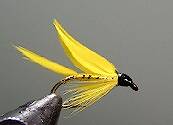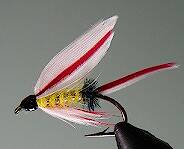
Salmonflies
Pteronarcys californica
The giant Salmonflies of the Western mountains are legendary for their proclivity to elicit consistent dry-fly action and ferocious strikes.
Featured on the forum

This specimen keys to the Epeorus albertae group of species. Of the five species in that group, the two known in Washington state are Epeorus albertae and Epeorus dulciana. Of the two, albertae has been collected in vastly more locations in Washington than dulciana, suggesting it is far more common. On that basis alone I'm tentatively putting this nymph in albertae, with the large caveat that there's no real information to rule out dulciana.

Troutnut is a project started in 2003 by salmonid ecologist Jason "Troutnut" Neuswanger to help anglers and
fly tyers unabashedly embrace the entomological side of the sport. Learn more about Troutnut or
support the project for an enhanced experience here.
Entoman on Oct 29, 2011October 29th, 2011, 11:25 am EDT
Beautiful, Mark. Yes, the modern hen is good stuff. I found a cape hanging by itself on the wall of a shop in Craig, Montana that in the old days we would have called a honey dun. The proprietor told me the dun strip running down the center was the only one of a shipment of gingers that looked that way and nobody wanted it. He offered it to me for 5 bucks. I walked out that day with a treasure. You know what the say - one man's junk is another man's...:) I'm supplied for quite awhile with the best Tup's hackles for PMD's I've ever seen. They're a little stiff for spring creeks but perfect for the freestones.
Also for some of us older guys that can remember the days before genetic hackle, the varying grades of india necks we used to grumble about offer a lot of interesting possibilites. I had the good fortune of being able to go through the huge bins that Andy Puyans would get in for grading before he shipped them out to all the fly shops. I collected some amazing stuff.
Regards,
Kurt
Also for some of us older guys that can remember the days before genetic hackle, the varying grades of india necks we used to grumble about offer a lot of interesting possibilites. I had the good fortune of being able to go through the huge bins that Andy Puyans would get in for grading before he shipped them out to all the fly shops. I collected some amazing stuff.
Regards,
Kurt
"It's not that I find fishing so important, it's just that I find all other endeavors of Man equally unimportant... And not nearly as much fun!" Robert Traver, Anatomy of a Fisherman
Softhackle on Oct 29, 2011October 29th, 2011, 12:42 pm EDT
Kurt
You got a real treasure at a good price. Try to find a honey dun, nowadays. The genetic hen necks are nice BUT, for some wets the chinese hen necks we use to get were great. I got a real nice selection of five necks, years ago from Herter's which I still have remnants of. I'm sure you remember Herter. Good stuff at reasonable prices. I got boxes of tying thread, which I still have but don't use anymore in favor of the finer, more modern threads. The threads were unwaxed, then, and I use to dip them in beeswax melted in a double boiler. The wax hot wax would penetrate the thread through.
Mark
PS
I forgot to mention that Leisenring would have loved the Brahma hen, not only for the stiffer quality, but for the dark list. He felt feathers like these represent both wing and legs. These feathers can be found dyed various colors. Some actually look like Badger and some like Furnace or Greenwells.
You got a real treasure at a good price. Try to find a honey dun, nowadays. The genetic hen necks are nice BUT, for some wets the chinese hen necks we use to get were great. I got a real nice selection of five necks, years ago from Herter's which I still have remnants of. I'm sure you remember Herter. Good stuff at reasonable prices. I got boxes of tying thread, which I still have but don't use anymore in favor of the finer, more modern threads. The threads were unwaxed, then, and I use to dip them in beeswax melted in a double boiler. The wax hot wax would penetrate the thread through.
Mark
PS
I forgot to mention that Leisenring would have loved the Brahma hen, not only for the stiffer quality, but for the dark list. He felt feathers like these represent both wing and legs. These feathers can be found dyed various colors. Some actually look like Badger and some like Furnace or Greenwells.
"I have the highest respect for the skilled wet-fly fisherman, as he has mastered an art of very great difficulty." Edward R. Hewitt
Flymphs, Soft-hackles and Spiders: http://www.troutnut.com/libstudio/FS&S/index.html
Flymphs, Soft-hackles and Spiders: http://www.troutnut.com/libstudio/FS&S/index.html
Entoman on Oct 29, 2011October 29th, 2011, 1:37 pm EDT
Mark -
Yes, and I couldn't agree more. Many modern tiers (myself included) who recognize this try to get around the lack of proper hackle by blending or facing. It's a noble effort and often times quite effective, but it isn't the same...
Regards,
Kurt
PS - Mention of the old Herter catalogs brings back some fond memories. I loved to pour through them for the reading. The descriptions and promotionals where quite entertaining.
I forgot to mention that Leisenring would have loved the Brahma hen, not only for the stiffer quality, but for the dark list. He felt feathers like these represent both wing and legs.
Yes, and I couldn't agree more. Many modern tiers (myself included) who recognize this try to get around the lack of proper hackle by blending or facing. It's a noble effort and often times quite effective, but it isn't the same...
Regards,
Kurt
PS - Mention of the old Herter catalogs brings back some fond memories. I loved to pour through them for the reading. The descriptions and promotionals where quite entertaining.
"It's not that I find fishing so important, it's just that I find all other endeavors of Man equally unimportant... And not nearly as much fun!" Robert Traver, Anatomy of a Fisherman
Oldredbarn on Oct 29, 2011October 29th, 2011, 7:35 pm EDT
Try to find a honey dun, nowadays. The genetic hen necks are nice BUT, for some wets the chinese hen necks we use to get were great.
Mark,
An unfortunate victim of the genetic craze (maybe that bird disease of a few years back as well). I still have some of those small necks. I was told to buy them years ago when my mentor and I were tearing through bins at the old "Fly Factory" in Grayling (Now the Old Au Sable). At the time I wasn't sure why I was buying them...Years later the light bulbs started to go off...I'm very happy I have them.
Spence
"Even when my best efforts fail it's a satisfying challenge, and that, after all, is the essence of fly fishing." -Chauncy Lively
"Envy not the man who lives beside the river, but the man the river flows through." Joseph T Heywood
"Envy not the man who lives beside the river, but the man the river flows through." Joseph T Heywood
Entoman on Oct 29, 2011October 29th, 2011, 11:40 pm EDT
Spence -
I agree. The hen necks are too stiff and too dense for some purposes. You have to really back off on your turns if you went 'em sparse.
BTW - stay away from those super-saddles. They are OK for parachutes I guess, but for standard hackling or collars? They're worse than useless... If you look closely at them, what makes them so stiff is their barbule shape. They are not round, they are blade shaped. And they get progressively thicker towards the base - much more so than traditional hackle. When wound on a hook conventionally, the fly becomes a miniature turbo fan! I started looking into it because it seemed every traditional hackled fly I tied with the crappy stuff twisted leaders all to hell. Let it go for "hair extensions" as Tony put it, who cares. You know?... For every patch of the things they grow for that market, they have a neck left over. I've heard their hatching chickens like crazy. Hmmm.... Anybody notice the price of necks coming down? Maybe it's not such a bad thing after all. Frankly, I'm more worried about a market crash when the damn things go out of style.:) Anyway, just my HO.
Regards,
Kurt
An unfortunate victim of the genetic craze (maybe that bird disease of a few years back as well).
I agree. The hen necks are too stiff and too dense for some purposes. You have to really back off on your turns if you went 'em sparse.
BTW - stay away from those super-saddles. They are OK for parachutes I guess, but for standard hackling or collars? They're worse than useless... If you look closely at them, what makes them so stiff is their barbule shape. They are not round, they are blade shaped. And they get progressively thicker towards the base - much more so than traditional hackle. When wound on a hook conventionally, the fly becomes a miniature turbo fan! I started looking into it because it seemed every traditional hackled fly I tied with the crappy stuff twisted leaders all to hell. Let it go for "hair extensions" as Tony put it, who cares. You know?... For every patch of the things they grow for that market, they have a neck left over. I've heard their hatching chickens like crazy. Hmmm.... Anybody notice the price of necks coming down? Maybe it's not such a bad thing after all. Frankly, I'm more worried about a market crash when the damn things go out of style.:) Anyway, just my HO.
Regards,
Kurt
"It's not that I find fishing so important, it's just that I find all other endeavors of Man equally unimportant... And not nearly as much fun!" Robert Traver, Anatomy of a Fisherman
Sayfu
Posts: 560
Posts: 560
Sayfu on Oct 30, 2011October 30th, 2011, 5:23 am EDT
Entomen...Man, you guys are into the nitty gritty reaching depths I never thought were even there! What do you think about the barbules that float the fly? Do the ones directly underneath that I most often trim off, penetrate the surface film, and do little to float the fly? The ones I leave angled out....are they the ones that primarily support the fly on the water?
Entoman on Oct 30, 2011October 30th, 2011, 8:24 am EDT
Sayfu -
Yep. But standard flies do float better, perhaps because they (bottom hackle) prevent in some way the lateral barbules from pulling through the meniscus as easy.
Kurt
Yep. But standard flies do float better, perhaps because they (bottom hackle) prevent in some way the lateral barbules from pulling through the meniscus as easy.
Kurt
"It's not that I find fishing so important, it's just that I find all other endeavors of Man equally unimportant... And not nearly as much fun!" Robert Traver, Anatomy of a Fisherman
Wiflyfisher on Nov 17, 2011November 17th, 2011, 7:25 am EST
I agree. The hen necks are too stiff and too dense for some purposes. You have to really back off on your turns if you went 'em sparse.
I have been starting to use some of the various Collins hen capes (which include the saddle patches) and find they are not as stiff as the Whiting hen capes. Plus, they have some really buggy colors that I find work well for wingless wets.
Mark, love your flies. You and Jim are the Leisenring Master Fly Nerds. :-)
John S.
https://WiFlyFisher.com
https://WiFlyFisher.com
Quick Reply
Related Discussions
Topic
Replies
Last Reply
13
Jun 29, 2011
by Softhackle
by Softhackle







